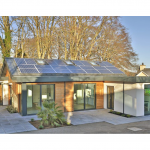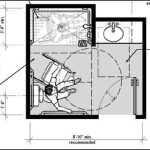Essential Guide to Handicap Bathroom Remodels for Aging in Place
A handicap bathroom is crucial for individuals facing mobility challenges or aging. These bathrooms are essential for those with limited mobility due to chronic conditions or falls. This article aims to provide a comprehensive guide on creating a handicap accessible bathroom that is both safe and stylish.
We will explore the necessary modifications and design features that will help individuals achieve a comfortable and accessible bathroom. Whether you are an individual with a disability, a caregiver, or a homeowner, this article will provide valuable insights on designing a bathroom that is safe, functional, and aesthetically pleasing.
Creating a safe and accessible bathroom is essential for individuals facing mobility challenges due to aging, chronic conditions, or falls. This article provides a comprehensive guide on designing a handicap accessible bathroom that is both safe and stylish.
We will explore necessary modifications and design features to help individuals achieve a comfortable and accessible bathroom. Whether you are an individual with a disability, a caregiver, or a homeowner, this article provides valuable insights on designing a bathroom that is safe, functional, and aesthetically pleasing.
The Importance of Handicap Bathrooms
A handicap bathroom is vital for people who have recently fallen or were diagnosed with a chronic condition that resulted in a mobility issue. Modern bathrooms may be fully functional and aesthetically pleasing for young homeowners and renters, but these styles are not always safe for elderly or disabled individuals.
Handicap showers can be a starting point for bathroom remodeling services, including a transfer shower, shower seat, and wheelchair access. Home renovations must be made so that these users can safely navigate their bathroom space as well. It is important to note that these spaces don’t have to sacrifice style or elegance!
The Benefits of Disability Modifications
As we age, mobility can become a challenge, making everyday tasks like using the bathroom difficult. But disability modifications can make a big difference. Whether you are renovating your home for yourself or looking for a house with handicap bathrooms, there is good news: creating an accessible bathroom design is simple when you know what changes to make.
With the right plan and professional help, you can pursue a bathroom remodel or build a handicap-safe home with ease. Our guide below will help you identify the modifications you need and how to make them effectively, so you can enjoy a bathroom that is both safe and comfortable.
Plan Your Accessible Bathroom
What’s needed to make a bathroom disability accessible?
Before you start modifying your new bathroom, you will need to choose a design that makes the bathroom easily accessible for you and other guests who may be using it.
In order to accomplish this, you want to consider your current needs as well as the needs that a timeless and modern bathroom design will provide for you in the future. In the planning, consider accessibility may require usage by a handicap wheelchair. You will also need:
- A bathroom to use while renovation is underway
- A budget for a renovation project
- Advice from someone who understand bathroom design for a disability and what can be done to help you reach the level of accessibility you need
- A vision of what your ideal finished product will look like: 3d rendering including selected bathroom fixtures
How can you build an accessible bathroom?
Accessibility looks different for every person as you will need to take both functionality and interior design into consideration. Some common modifications made for a more accessible bathroom design include: safety tub, shower seat, pedestal sink, sink height, wheelchair access, and pocket door.
- Widening each doorway to allow for the passage of a wheelchair or walker
- Adding grab bars near the toilet, in the shower stall, or tub to make getting out of or onto certain surfaces easier for those using the facilities.
- You may also wish to build a curbless shower so that stepping in and out is safer for those using it.
- Selecting a raised toilet seat to make sitting down easier
- Smoothing out the transition between bathroom flooring and bedroom/hallway flooring
- Lowering shelves and other storage areas, selecting a floating bathroom sink
- Converting a bathtub into a walk-in shower
- Installing sensor lights
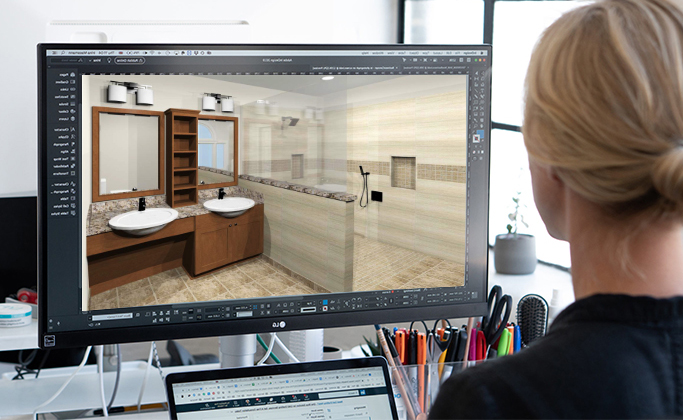
What are some options for Accessible Bathroom Designs?
It’s important to understand that the Americans with Disabilities Act (ADA) guidelines for creating accessible bathrooms are primarily intended for commercial spaces. If you’re planning to renovate a bathroom in your home and have limited space, these guidelines may not be required.
Instead, you may want to consider a universal design approach which aims to create spaces that are accessible to people of all abilities, ages, and sizes. This approach can help ensure that your handicap bathroom layout is functional, safe, and accessible for everyone who needs to use it.
What are some options for Bathroom Layout?
According to the ADA, an accessible bathroom should meet the following room size criteria:
- 30 inches by 48 inches from the door to the sink
- At least 60 inches around the side and 56 inches from the rear so a wheelchair can turn around with ease
The toilet in the bathroom should be at least 17-19 inches off of the ground to make transitioning from a wheelchair to a toilet seat easier.
How Wide Should The Bathroom Door Be?
The doorway should be at least 32 inches wide to accommodate wheelchairs and walkers. Clearance around the door should be at least 36 inches.
What is required for Bathroom Handrails and grab bars?
Bathroom handrails and grab bars are essential components of a handicap accessible bathroom. In order to make sure your toilet is easily accessible, you will need to have a grab bar either on the rear wall or the wall parallel to the toilet. If it’s on the rear wall, it should be at least 36 inches long and between 33-36 inches off of the ground. The end closest to the sidewall should extend at least 12 inches from the centerline of the toilet and 24 inches from the other side.
On the other hand, if the grab bar is on the sidewall parallel to the toilet, it should be at least 42 inches long and also between 33-36 inches off of the ground. It should start no more than 12 inches away from the rear wall and extend to at least 54 inches away from the back wall.
For easy grip, the bar should have a diameter of 1 ¼ to 1 ½ inches. By following these guidelines, you can ensure that your bathroom is safe and accessible for those with mobility challenges or disabilities.
Walk-in Shower FAQs
What Is A Walk-in Shower?
A walk-in shower is one you can walk (or roll) into without any obstacles, such as a lip, edge, or step. This allows for easier access for anyone with a walker or wheelchair. These do not require a shower curtain or door to block the spray of water, resulting in an open spacious feeling. Wheelchair access is important for safe showering.
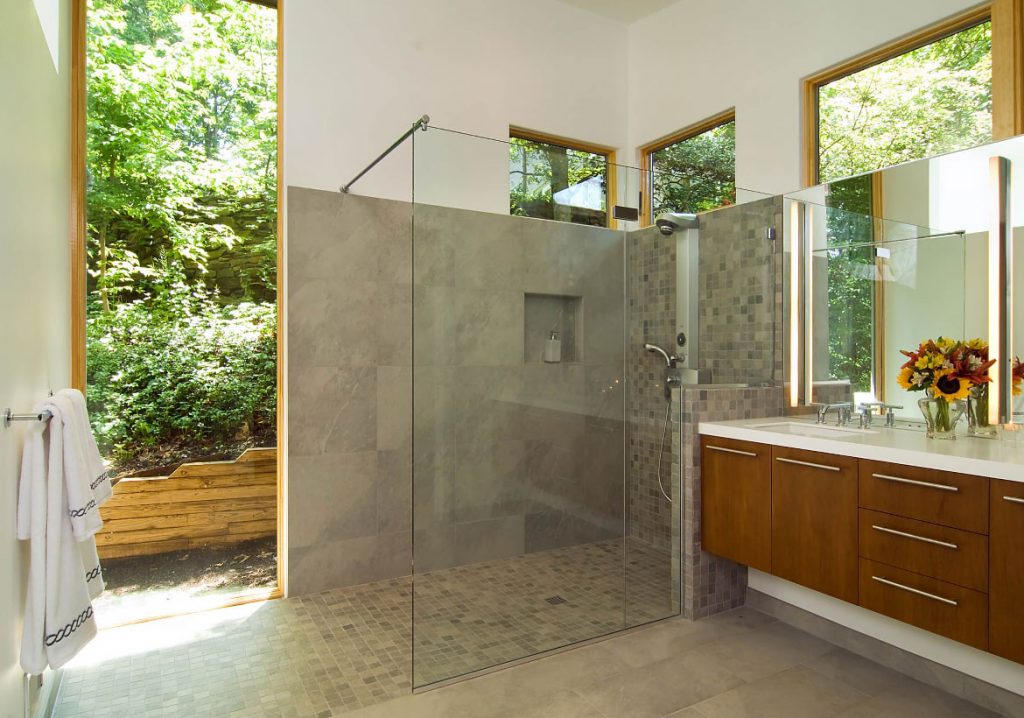
A shower seat can also be added for those who need assistance while bathing. Handicap remodeling contractors can provide the bathroom remodeling services needed for the addition of a shower seat.
While some prefab units have shallow curbs to keep excess water from running onto the bathroom floor, many kits are designed with no curbs. Most kits are supported by a video demo so that contractors can perform installation correctly. The shower pan sits just below floor level. There is a gradual smooth entry—which means greater accessibility and a big benefit for those with joint pain or mobility issues.
Safety grab bars may also be necessary to ease the transition into the space, and you may need to add a chair as well.
How can you build one?
Depending on the bathroom layout you currently have, you may be able to make simple adjustments to create an accessible design. Many people remove their current shower stall and install a shower kit that works for their floor plan. If you have a tub in your current bathroom, a remodeling contractor can remove the tub and install a walk-in shower enclosure.
With a small bathroom sometimes the best way to create accessibility is to turn the entire bathroom into a wet room, where handicap showers are easily accessible to people with limited mobility.
What Are Some Options For Walk-in Designs?
There are a lot of ways to approach designing a safe shower stall and chances are that you’ve seen a few in an elegant bathroom photo that matches home decor. Most likely, you will have to look at your current bathroom and how much floor space you have to work with. A handicap shower remodel involves maximizing the bathroom layout, and selecting appropriate bathroom fixtures.
Handicap showers should be enclosed by two walls that are parallel or perpendicular to each other. To further enclose the space and prevent water from reaching the rest of your bathroom floor, you could:
- Install a glass wall to seal off the third side
- Install a curtain rod and shower curtain if that is accessible for those in the house (although we recommend the glass instead)
- Build a shelf that blocks the floor from the rest of the bathroom but leaves an open space for access and storage
- Add a shower seat
- Add an accessible shower head and a faucet that can be reached from a seated position – a handheld shower head is generally a good option
- For added luxury, consider soap dispensers for easy access to your bath products. You can always look for design inspiration online or use a service like Houzz to help you figure out what the best design for your home will be.
Consult a Certified Aging in Place Specialist for more ways that you can design your bathing area that provides accessibility and safety.
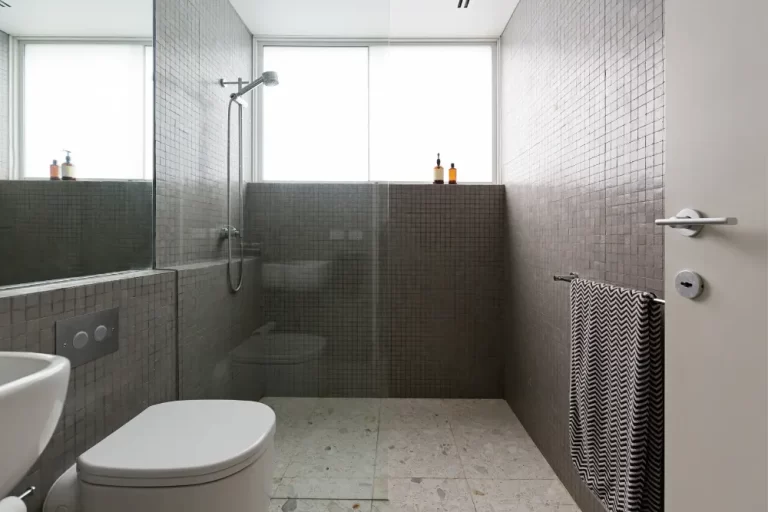
How to Waterproof Your Bathroom Floor for a Safe and Secure Home
To prevent water damage and slips in your bathroom, it’s important to waterproof the floor during a shower remodel. To do this, you can use waterproof materials and a shower pan.
For the floor, choose a waterproof paint that can handle steam. You can also use a waterproof pan liner to protect the rest of your bathroom floor, and consider adding rubber flooring outside the walk-in shower area to contain water.
To further waterproof the showering area, you’ll want to install a membrane beneath the ceramic tiles and grout. This will help protect the foundation of your home from water damage.
How do you clean a walk-in?
Cleaning a walk-in is not much different than cleaning a regular shower. Keep a mop and cleaning agents nearby to remove soap scum from the floor and keep all surfaces looking nice.
Use a spray after each use to make sure that the walls and surfaces stay fresh. If you choose to have a glass barrier, buy specialty glass cleaner to keep it sparkling.
The main concern is keeping your space clear for accessibility and ensuring clean, dry surfaces to avoid accidents.
Cost of Modifications to a Handicap Bathroom and Resources
How much does it cost for a bathroom remodel?
On average, a complete remodel can cost $25,000 or more, depending on the scope of work and modifications required. This includes:
- Installing a walk-in shower
- Modifying the bathroom layout for accessibility
- Replacing fixtures with accessible ones
- Installing grab bars and rails
- Waterproofing the bathroom floor
The cost of a walk-in shower can vary widely, with a prefabricated kit ranging from $800 to $2,500, and a custom-built shower costing anywhere from $4,000 to $8,000 or more. Other modifications, such as widening doorways and hallways, installing a new toilet or sink, or replacing flooring and tiles, can also add to the total cost of the project.
Additionally, it’s important to keep in mind that moving plumbing lines can also significantly impact the cost of a handicap bathroom remodel. In some cases, it may be possible to work with the existing location of drains and water pipes to keep costs down. However, if major modifications to the plumbing are required to accommodate a new layout or fixtures, this can add a substantial amount to the overall cost of the project. It’s important to discuss plumbing options with your contractor or specialist and factor in the cost of any necessary plumbing changes when estimating the total cost of the project.
If you need to completely change the design and layout of your bathroom, the average cost will most likely exceed $35,000. Installing safety grab bars and replacing the flooring may end up costing upwards of $2,000. It’s important to consult with a design professional that understands both your health situation and accessible products before you start a bath remodel.
How much does a walk-in shower cost to install?
If you are buying a walk-in kit, expect to pay between $800 and $2,500 for just the kit (not the labor to install). Costs will vary depending on whether you want to install tile, waterproofing material, or additional storage. Plumbing is a cost factor if the placement of a stall does not utilize the existing location of drains and water pipes.
To keep costs down plumbing lines should not be moved, and existing locations of faucets and drains should be maintained, unless for accessibility reasons appliances require different locations. Safety tub is a good starting point for bathroom remodeling services
Will Medicare pay for a handicap bathroom?
Medicare may be able to take care of some of the costs that you will need to pay bathroom remodeling contractors. Likewise, Durable Medical Equipment (DME) like commode chairs may be covered by Medicare.
Do not expect every expense to be covered by insurance. For example, if you turn to Houzz for interior decorating help and these modifications are not considered “medically necessary,” you will most likely have to pay for them out of pocket.
What specialists can help me begin this bathroom project?
Seek out a contractor who is also a Certified Aging in Place Specialist. They can help you adapt your bathroom based on universal design concepts and regulations, among other necessary guidelines.
What It Means to Hire a Certified Aging in Place Specialist (CAPS)
Seeking out a contractor who is also certified as an Aging in Place Specialist (or CAPS-certified) will ensure your bathroom renovation meets the highest of standards. Part of their training involves learning the principles of Universal Design and their study is dedicated to understanding relevant guidelines. Let’s look at a few important highlights of each…
Why Would I Choose A Plan Based On Universal Design?
Universal Design actually strives to create an environment that can meet the needs of every person who uses it. It isn’t meant to address only a minority population (those with disabilities or handicaps for instance). Rather, it establishes “good design” as a fundamental condition.
When you choose a contractor who specializes in a universal concept of accessible design, from light fixtures to bathroom rails down to toilet seat options, you know the result of your bathroom remodel will be beautiful and functional. It will be an accommodation you and every visitor you have will love.
Aren’t American with Disabilities Act guidelines actually for public places?
The Americans with Disabilities Act ensures that those with disabilities have equal access to work, education, and their community. It is true that this does include certain guidelines for developing public accommodations for the handicapped population.
Requirements do primarily address projects in the United States that involve a commercial facility or some type of multi-family housing. However, our CAPS-certified contractors incorporate the same level of quality outlined in the above standards into private facilities’ accessible design as well.
What are some of the most common ways you incorporate ADA requirements?
Besides the ones we’ve mentioned throughout this article, common updates taken from guidelines on a place of public accommodation include:
- Doors with lever handles (levers instead of knobs) that require no more than 5 pounds of force to open
- Each doorway designed to be wider than normal to allow enough room for passage by a wheelchair user
- Enough clear floor space to provide accessible routes for a wheelchair user throughout a dwelling
- Light switches, electrical outlets, thermostats, etc. placed so that they are accessible by all
- Countertops 38 inches or lower, counter edge protectors less than 2 inches, and, under a built-in vanity, knee clearance is 17 inches minimum
Should I plan for another renovation in the future to specifically address aging, too?
That all depends. Talk with your Certified Aging in Place Specialist about both short and long-term goals. Perhaps you want to go ahead and update your new bathroom for all life stages. Maybe it makes more financial sense to execute in stages.
Whichever option you choose, you can expect that your CAPS contractor will design something that works for you now and will be adaptable in the future.
Additionally, you’ll find that contractors with these certifications typically maintain the same overall goals for their clients as set forth by the Older Americans Act, Title III:
- Provide support services to secure and maintain maximum independence and dignity in a home environment
- Remove barriers — both individual and social — to economic and personal independence
- Play a small part in providing a continuum of care to aging adults
Who should I contact about a CAPS-certified contractor?
Today, we’ve only covered a few of the considerations a CAPS-trained contractor will make when designing lavatory updates to meet the needs of people who require special accommodations, but it doesn’t stop there! Some CAPS-certified contractors even consult international organizations like the ICC for building safety guidelines.
The bottom line is, these professionals care about both your safety and beautiful design, whether you plan on using that bathroom down the road or showing it off during a Friday preview. Ultimately, when choosing a bathroom contractor for your bathroom modifications, CAPS is the way to go for aging in place!
Here at Living In Place Designs, we pride ourselves on being CAPS-certified professionals.



